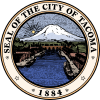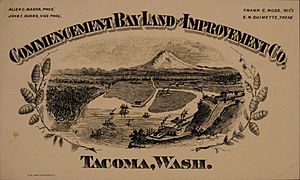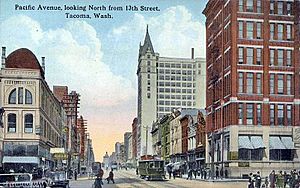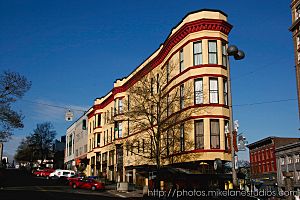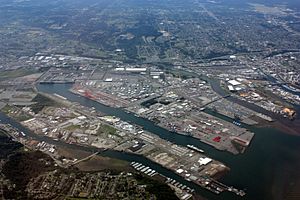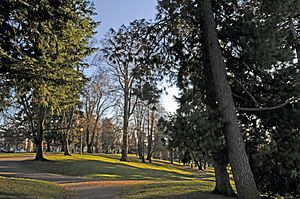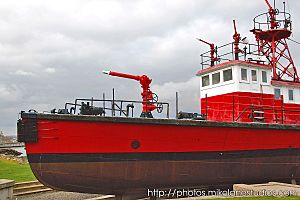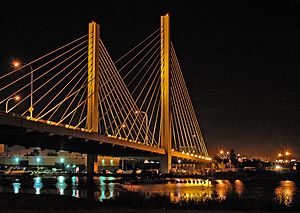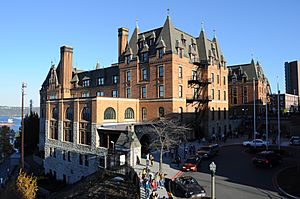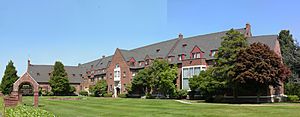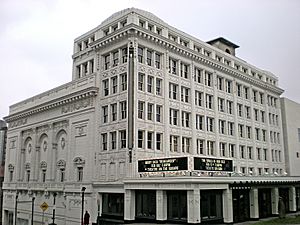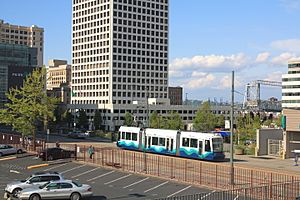Tacoma, Washington facts for kids
Quick facts for kids
Tacoma
|
|||
|---|---|---|---|

Aerial view of Downtown Tacoma with Mount Rainier in the background
|
|||
|
|||
| Nickname(s):
City of Destiny, Grit City
|
|||
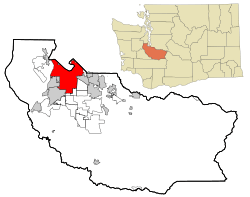
Location of Tacoma in
Pierce County and Washington state |
|||
| Country | United States | ||
| State | Washington | ||
| County | Pierce | ||
| Adopted | 1868 | ||
| Founded | 1872 | ||
| Incorporated | November 12, 1875 | ||
| Named for | Tahoma | ||
| Government | |||
| • Type | Council–manager | ||
| Area | |||
| • City | 62.42 sq mi (161.68 km2) | ||
| • Land | 49.71 sq mi (128.76 km2) | ||
| • Water | 12.71 sq mi (32.92 km2) | ||
| Elevation | 249 ft (76 m) | ||
| Population
(2020)
|
|||
| • City | 219,346 | ||
| • Estimate
(2023)
|
222,906 | ||
| • Rank | US: 105th WA: 3rd |
||
| • Density | 4,412.51/sq mi (1,703.53/km2) | ||
| • Urban | 3,544,011 (Seattle urban area) (US: 13rd) | ||
| • Metro | 4,034,248 (Seattle metropolitan area) (US: 15th) | ||
| Demonym(s) | Tacoman (plural: Tacomans) | ||
| Time zone | UTC–8 (Pacific (PST)) | ||
| • Summer (DST) | UTC–7 (PDT) | ||
| ZIP codes |
Zip codes
|
||
| Area code | 253 | ||
| FIPS code | 53-70000 | ||
| GNIS feature ID | 1512713 | ||
Tacoma is a port city in Washington, United States. It is the main city of Pierce County. Tacoma is located along Puget Sound, about 32 miles (51 km) southwest of Seattle.
The city's name comes from nearby Mount Rainier. The mountain was called təˡqʷuʔbəʔ by the Puyallup tribe. Tacoma is known as the "City of Destiny". This is because it was chosen as the end point for the Northern Pacific Railroad in the late 1800s. Tacoma's deep-water harbor, Commencement Bay, was perfect for connecting trains and ships. This led to the city's motto: "When rails meet sails".
The Port of Tacoma is a major center for international trade on the Pacific Coast. It is Washington's largest port. In 1940, the Tacoma Narrows Bridge collapsed. It was nicknamed "Galloping Gertie" because it moved a lot in the wind.
Like many industrial cities, Tacoma faced challenges in the mid-1900s. However, since the 1990s, downtown Tacoma has been revitalized. New developments include the University of Washington Tacoma and the T Line, which is the state's first modern electric light rail. The city also has many art and history museums, and a beautiful waterfront area called the Thea Foss Waterway.
Contents
- Tacoma's History and Growth
- Tacoma's Geography and Climate
- Tacoma's Population and People
- Tacoma's Economy and Jobs
- Parks and Fun Places in Tacoma
- Tacoma's Buildings and Bridges
- Learning and Schools in Tacoma
- Arts and Culture in Tacoma
- Sports in Tacoma
- Getting Around Tacoma
- City Services
- Famous People from Tacoma
- Tacoma's Sister Cities
- See also
Tacoma's History and Growth
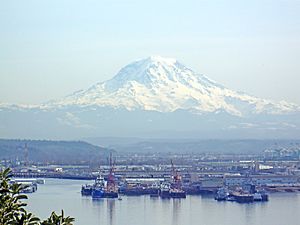
For thousands of years, the area where Tacoma now stands was home to American Indians. The Puyallup tribe lived in settlements on the river delta.
In 1852, a man named Nicolas Delin built a sawmill. A small settlement grew around it. However, it was abandoned during the Indian War of 1855–56. In 1864, Job Carr, a pioneer, built a cabin. This cabin also served as Tacoma's first post office. He later sold most of his land to Morton M. McCarver. McCarver named his project Tacoma City, using the local name for the mountain.
Tacoma officially became a city on November 12, 1875. This happened after Old Tacoma and New Tacoma joined together. The city's dream of becoming the "City of Destiny" came true in 1873. That's when it was chosen as the western end of the Northern Pacific Railroad. The population grew quickly, from 1,098 people in 1880 to 36,006 in 1890.
In 1889, writer Rudyard Kipling visited Tacoma. He said the city was "literally staggering under a boom of the boomiest." A famous traveler, George Francis Train, lived in Tacoma for a few years. In 1890, he started and ended a trip around the world in Tacoma to promote the city. A plaque downtown marks the spot.
In November 1885, some white citizens forced several hundred Chinese residents to leave the city. The Chinese Reconciliation Project Foundation describes how people were made to board a train to Portland, Oregon. The next day, two Chinese settlements were burned down.
When gold was discovered in the Klondike in 1898, Seattle grew much faster. This made Seattle more prominent than Tacoma for a while.
Tacoma in the 1900s
A sad event happened on July 4, 1900, when a streetcar accident caused many deaths.
From 1915 to 1922, Tacoma was a big place for car racing. One of the nation's top racing tracks was just outside the city.
The Great Depression and "Hollywood"
The Great Depression hit Tacoma hard in the winter of 1929–30. It was one of the coldest winters ever. The city had power outages and major dams shut down. This left Tacoma without enough power and heat. During a 30-day power shortage, the aircraft carrier USS Lexington provided electricity.
Many local businesses struggled, and families faced foreclosures. People found it hard to get food. A shantytown, or makeshift community, grew in the train yard. It was called "Hollywood" because of some of the events that happened there. Families built shacks from scraps of wood and metal.
- 1924 – Tacoma starts feeling the effects of the economic problems.
- 1927 – Tacoma's shantytown is nicknamed "Hollywood."
- 1937 – Tacoma holds a meeting to discuss the problems of the shantytown.
- 1940 – Police try to clear out "Hollywood" by burning down the shacks.
- 1956 – The last person living in "Hollywood" is removed. Police burn down the area again to make space for new buildings.
In 1935, George Weyerhaeuser, the son of a famous lumber executive, was kidnapped. FBI agents helped solve the case. A ransom was paid, and the boy was safely returned.
In 1951, an investigation found a lot of corruption in Tacoma's government. In response, voters changed the city's government system in 1952.
Tacoma was important in the garage rock music scene of the mid-1960s. Bands like The Wailers and The Sonics were from Tacoma. The surf rock band The Ventures also started here.
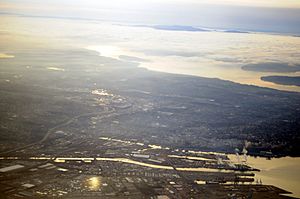
Downtown Tacoma faced a long decline in the mid-1900s. But around 1990, things started to change. Old buildings were restored, and new ones were built. These included the federal courthouse (1991), the Washington State History Museum (1996), and the University of Washington Tacoma campus. The Museum of Glass (2002) and the Tacoma Art Museum (2003) also opened. The city also got its first light-rail line in 2003.
In 1998, Tacoma installed a high-speed fiber optic network. The city's power company, Tacoma Power, wired the whole city.
Tacoma in the 2000s
In the 1980s and early 1990s, Tacoma's Hilltop neighborhood had a lot of crime. Some people even called the city "Tacompton." However, crime has gone down a lot in the 21st century. Neighborhoods have worked with police to make things safer.
In 2004, Tacoma was named one of the top 30 Most Livable Communities. In 2009, Marilyn Strickland became Tacoma's second African-American mayor.
Downtown Revival
Since the early 1990s, Tacoma has worked to make its downtown area better. The University of Washington opened a campus in Tacoma in 1990. The Union Station building was also restored that year.
The Museum of Glass opened in 2002. It shows glass art from around the world. It has a glassblowing studio and is connected to other museums by the Bridge of Glass. This bridge features art by Tacoma native Dale Chihuly.
Tacoma's Cultural District also has the Washington State History Museum (1996) and the Tacoma Art Museum (2013). America's Car Museum opened in 2011 near the Tacoma Dome. The Greater Tacoma Convention and Trade Center opened in 2004.
The Theatre District has the Pantages Theater, which first opened in 1918. The Broadway Center for the Performing Arts manages several theaters. Other attractions include the Grand Cinema and the Temple Theatre.
Tacoma's Geography and Climate
Tacoma is located at 47.241371 degrees North and -122.459389 degrees West. Its elevation is about 249 feet (76 meters) above sea level.
The city covers about 62.34 square miles (161.46 square kilometers). About 49.72 square miles (128.77 square kilometers) is land, and 12.62 square miles (32.68 square kilometers) is water.
Tacoma is next to Commencement Bay. Many areas of Tacoma have great views of Mount Rainier. If Mount Rainier has a major eruption, some parts of Tacoma could be affected by lahars, which are dangerous mudflows.
The city is a few miles north of Joint Base Lewis-McChord, a large military base.
Tacoma's Climate
Tacoma has a mild climate, often described as a Mediterranean or Oceanic climate. This means it has warm, dry summers and cool, wet winters.
| Climate data for Tacoma, Washington | |||||||||||||
|---|---|---|---|---|---|---|---|---|---|---|---|---|---|
| Month | Jan | Feb | Mar | Apr | May | Jun | Jul | Aug | Sep | Oct | Nov | Dec | Year |
| Record high °F (°C) | 66 (19) |
68 (20) |
77 (25) |
82 (28) |
92 (33) |
94 (34) |
94 (34) |
93 (34) |
89 (32) |
82 (28) |
71 (22) |
68 (20) |
94 (34) |
| Mean daily maximum °F (°C) | 48 (9) |
51 (11) |
56 (13) |
60 (16) |
66 (19) |
72 (22) |
77 (25) |
77 (25) |
71 (22) |
61 (16) |
53 (12) |
47 (8) |
61.6 (16.4) |
| Mean daily minimum °F (°C) | 37 (3) |
37 (3) |
40 (4) |
43 (6) |
48 (9) |
53 (12) |
56 (13) |
56 (13) |
52 (11) |
46 (8) |
40 (4) |
36 (2) |
45.3 (7.4) |
| Record low °F (°C) | 17 (−8) |
11 (−12) |
15 (−9) |
29 (−2) |
34 (1) |
37 (3) |
47 (8) |
41 (5) |
34 (1) |
26 (−3) |
5 (−15) |
6 (−14) |
5 (−15) |
| Average precipitation inches (mm) | 5.93 (151) |
4.00 (102) |
4.06 (103) |
3.00 (76) |
2.11 (54) |
1.57 (40) |
0.68 (17) |
0.82 (21) |
1.29 (33) |
3.70 (94) |
6.68 (170) |
5.52 (140) |
39.36 (1,000) |
| Source 1: NOAA | |||||||||||||
| Source 2: The Weather Channel | |||||||||||||
Neighboring Cities
 |
Gig Harbor | Vashon Island | Federal Way |  |
| Fox Island | Fife | |||
| Lakewood | Parkland | Puyallup |
Tacoma's Population and People
| Historical population | |||
|---|---|---|---|
| Census | Pop. | %± | |
| 1870 | 73 | — | |
| 1880 | 1,098 | 1,404.1% | |
| 1890 | 36,006 | 3,179.2% | |
| 1900 | 37,714 | 4.7% | |
| 1910 | 83,743 | 122.0% | |
| 1920 | 96,965 | 15.8% | |
| 1930 | 106,817 | 10.2% | |
| 1940 | 109,408 | 2.4% | |
| 1950 | 143,673 | 31.3% | |
| 1960 | 147,979 | 3.0% | |
| 1970 | 154,407 | 4.3% | |
| 1980 | 158,501 | 2.7% | |
| 1990 | 176,664 | 11.5% | |
| 2000 | 193,556 | 9.6% | |
| 2010 | 198,397 | 2.5% | |
| 2020 | 219,346 | 10.6% | |
| 2023 (est.) | 222,906 | 12.4% | |
| source: U.S. Decennial Census 2020 Census |
|||
Population in 2020
In 2020, Tacoma had 219,346 people living in the city. There were 91,951 households.
| Race / Ethnicity (NH = Not Hispanic) | Pop 2000 | Pop 2010 | Pop 2020 | % 2000 | % 2010 | % 2020 |
|---|---|---|---|---|---|---|
| White alone (NH) | 128,696 | 119,981 | 120,118 | 66.49% | 60.48% | 54.76% |
| Black or African American alone (NH) | 21,187 | 21,222 | 21,708 | 10.95% | 10.70% | 9.90% |
| Native American or Alaska Native alone (NH) | 3,398 | 2,988 | 2,910 | 1.76% | 1.51% | 1.33% |
| Asian alone (NH) | 14,508 | 16,013 | 19,932 | 7.50% | 8.07% | 9.09% |
| Pacific Islander alone (NH) | 1,740 | 2,358 | 4,174 | 0.90% | 1.19% | 1.90% |
| Other race alone (NH) | 504 | 394 | 1,399 | 0.26% | 0.20% | 0.64% |
| Mixed Race or Multi-Racial (NH) | 10,261 | 13,051 | 20,090 | 5.30% | 6.58% | 9.16% |
| Hispanic or Latino (any race) | 13,262 | 22,390 | 29,015 | 6.85% | 11.29% | 13.23% |
| Total | 193,556 | 198,397 | 219,346 | 100.00% | 100.00% | 100.00% |
In 2010, there were 198,397 people in Tacoma. About 23% of residents were under 18 years old. The average age in the city was 35.1 years.
Tacoma's Economy and Jobs
Tacoma is home to several international companies. These include True Blue Inc., a staffing company, and Simpson, a lumber company. Food companies like Roman Meal and Brown and Haley are also based here. Frank C. Mars started Mars, Incorporated, in Tacoma in 1911.
Starting in the 1930s, Tacoma was known for the "Tacoma Aroma." This was a strong smell from the paper mills. In the late 1990s, the Simpson Tacoma Kraft mill greatly reduced its sulfur emissions. This mostly got rid of the smell. Now, you only notice it sometimes when the wind blows from the east.
U.S. Oil and Refining runs an oil refinery in the Port of Tacoma. It was built in 1952 and processes 39,000 barrels of oil each day.
The Tacoma Mall is the biggest shopping center in the city. It has major stores like JC Penney, Macy's, and Nordstrom.
Hospitals in Tacoma are run by MultiCare Health System and Franciscan Health System. These include MultiCare Tacoma General Hospital and Mary Bridge Children's Hospital.
Major Employers in Tacoma
Here are some of the largest employers in Tacoma:
| # | Employer | Type of Business | # of Employees | Percentage |
|---|---|---|---|---|
| 1 | Joint Base Lewis–McChord | Military | 54,000 | 5.7% |
| 2 | MultiCare Health System | Health Care | 8,264 | 0.9% |
| 3 | State of Washington | Government | 7,859 | 0.8% |
| 4 | CHI Franciscan Health | Health Care | 5,682 | 0.6% |
| 5 | Tacoma Public Schools | Education | 3,649 | 0.4% |
| 6 | City of Tacoma | Government | 3,623 | 0.4% |
| 7 | Pierce County | Government | 3,304 | 0.3% |
| 8 | Puyallup School District | Education | 2,711 | 0.3% |
| 9 | Bethel School District | Education | 2,689 | 0.3% |
| 10 | Safeway and Albertsons | Retail Grocery | 2,153 | 0.2% |
| — | Total employers | — | 93,934 | 9.9% |
Parks and Fun Places in Tacoma
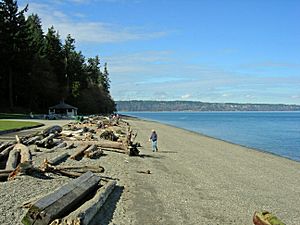
Metro Parks Tacoma manages over fifty parks and open spaces in the city.
Point Defiance Park is one of the largest urban parks in the country, covering 700 acres. You can drive along Scenic Five-Mile Drive to see many attractions. These include Owen Beach, Fort Nisqually, old growth forest trails, and the Point Defiance Zoo & Aquarium (PDZA). The Pagoda, a historic building, was rebuilt after a fire in 2011. It is now used for events.
Ruston Way is a waterfront area along Commencement Bay. It has several public parks connected by a multi-use trail. This trail is popular for walking, running, and biking. There are also beaches for swimming and scuba diving.
Wapato Park is another large park in Tacoma. It has a lake and walking trails around it. Titlow Beach is also a popular spot for scuba diving.
Wright Park, near downtown, is a beautiful English-style park. It has the Wright Park Arboretum and the W. W. Seymour Botanical Conservatory.
Jefferson Park in North Tacoma has a new "sprayground." This is a fun play area where water sprays from different features. Frost Park in downtown Tacoma often hosts sidewalk chalk contests.
Tacoma also has dog parks for its growing dog population. Rogers Off-Leash Dog Park is one such public park.
Tacoma's Buildings and Bridges
Tacoma has many important buildings and landmarks. Famous architects like Frederick Heath worked here.
Two suspension bridges cross the Tacoma Narrows. These bridges connect Tacoma to Gig Harbor and the Kitsap Peninsula. The first Tacoma Narrows Bridge collapsed in 1940. This event is a famous example studied in architecture classes.
Historic Places in Tacoma
Many properties in Tacoma are listed on historic registers. This means they are important to the city's history.
Engine House No. 9 is a fire station built in 1907. It is now a pub that brews its own beer.
Stadium High School and the Stadium Bowl were used as a setting for the movie 10 Things I Hate About You.
Fireboat No. 1 was built in 1929. It served the Port of Tacoma for 54 years, helping with fires and rescues. Now, it is on display at a public beach. It is one of only five fireboats recognized as a National Historic Landmark.
The Murray Morgan Bridge is a steel lift bridge built in 1911. It crosses the Thea Foss Waterway. It was closed for repairs but reopened in 2013.
Other notable buildings include the Perkins Building, the Tacoma Dome, and Tacoma Union Station.
Learning and Schools in Tacoma
Most of Tacoma is served by Tacoma Public Schools. The district has 36 elementary schools, eleven middle schools, and 10 high schools. This includes special high schools like SAMi (Science and Math Institute), SOTA (School of the Arts), and iDEA (Industrial Design, Engineering, and Art).
Henry Foss High School has an International Baccalaureate program. Mount Tahoma High School opened a new building in 2004. Stadium High School and Wilson High School were updated and reopened in 2006.
Tacoma School of the Arts (SOTA) opened in 2001. It is a public high school focused on arts. SOTA uses museums and universities in downtown Tacoma for learning. In 2009, the Science and Math Institute (SAMI) opened. It focuses on science and math. In 2017, iDEA opened, focusing on design and engineering.
Lincoln High School reopened in 2007 after a big renovation.
Tacoma also has many private schools. These include Evergreen Lutheran High School and the Annie Wright Schools.
For higher education, Tacoma has the University of Puget Sound, Tacoma Community College, and satellite campuses of The Evergreen State College and the University of Washington. Pacific Lutheran University is just south of the city in Parkland.
Arts and Culture in Tacoma
Tacoma has a program to use one percent of construction costs for public art. This helps bring more art to the city.
- The Museum of Glass has a unique steel cone building. It is known for its glassblowing studio. The Bridge of Glass connects it to other museums and features art by Dale Chihuly.
- LeMay-America's Car Museum opened in 2012. It displays 300 cars, from old to new. It honors Harold LeMay's large car collection.
- Tacoma Art Museum was founded in 1935. It moved to a new building in 2003, forming a "museum district" with the Museum of Glass and the Washington State History Museum.
- Foss Waterway Seaport is a heritage museum. It has hands-on exhibits, a wooden boat shop, and a functional dock. It shows the history of marine life in the South Sound.
- Fort Nisqually was a fur trading post built in 1833. The fort you see today was rebuilt in the 1930s. It helps visitors experience life in 1855.
- Buffalo Soldiers Museums: This museum honors the brave African American soldiers known as Buffalo Soldiers. It shows their challenges and triumphs.
- Washington State History Museums (WSHM) explores how history connects everyone.
- Point Defiance Zoo and Aquarium (PDZA) is the only combined zoo and aquarium in the Pacific Northwest. It is known for its high standards of animal care and conservation.
- Tacoma Arts Live manages three theaters, including the historic Pantages Theater. These theaters host the Tacoma Opera, Tacoma Symphony Orchestra, and other performing arts groups.
- The Tacoma Film Festival happens every year at the Grand Cinema.
- The Tacoma farmers' market runs from May to October in the Theatre District.
- Tacoma hosts part of the annual Daffodil Parade every April.
- Shakespeare in the Parking Lot performs plays by William Shakespeare in unusual places.
Sports in Tacoma
| Team | Sport | League | Founded | Venue |
|---|---|---|---|---|
| Tacoma Rainiers | Baseball | Pacific Coast League | 1960 | Cheney Stadium |
| Tacoma Defiance | Soccer | MLS Next Pro | 2014 | Cheney Stadium |
| Tacoma Stars | Indoor Soccer | Major Arena Soccer League | 2003 | ShoWare Center (Kent) |
The Tacoma Dome is the city's main sports venue. It opened in 1983 and hosts many events. These include pro-wrestling, figure-skating tours, and the Harlem Globetrotters.
Tacoma has a history with minor-league hockey teams. The original Tacoma Rockets played from 1946 to 1953. The team was brought back in 1991 but moved in 1995. The Tacoma Sabercats then played from 1997 to 2002, winning a championship in 1999.
Cheney Stadium is home to the Tacoma Rainiers. They are a AAA minor league baseball team. They have been connected with the Seattle Mariners since 1995. Both the Tacoma Dome and Cheney Stadium hosted events during the 1990 Goodwill Games.
Tacoma also has a long history with soccer. The Tacoma Defiance soccer team plays in the MLS Next Pro league. They are the reserve team for MLS's Seattle Sounders FC. The city's first professional soccer team was the Tacoma Tides in 1976.
In women's outdoor soccer, Reign FC played their home games at Cheney Stadium from 2019 to 2021.
The Tacoma Stars indoor soccer team started in 1983. The original team stopped playing in 1992, but a new team was formed in 2003. Since 2015, the new Stars play in the Major Arena Soccer League.
Tacoma is also home to the Dockyard Derby Dames, an all-female roller derby league. There are many golf courses in Tacoma, including Lake Spanaway Golf Course.
Getting Around Tacoma
Tacoma's transportation mostly relies on cars. The city has a grid system of streets. Numbered streets usually run east-to-west, and named or lettered streets run north-to-south. This system can sometimes be confusing because streets with the same number can be found in both north and south Tacoma.
Some areas of the city have denser business districts with mixed uses. These areas often have "small town"-style parades and festivals. Examples include the Proctor District, Old Town, and 6th Avenue.
Roads and Highways
Seven highways pass through or end in Tacoma. These include I-5, I-705, SR 7, and SR 16.
Interstate 5 is the main highway connecting Tacoma to Seattle in the north and Portland, Oregon, in the south. State Route 16 connects I-5 to West Tacoma, the Tacoma Narrows Bridge, and the Kitsap Peninsula.
Air Travel
Seattle–Tacoma International Airport is about 22 miles (35 km) north of Tacoma. Tacoma helped pay for the airport's construction.
A seaplane service offers tours of the Tacoma area from a dock near Old Town.
Public Transportation
Tacoma has a public transportation system with buses, commuter rail, light rail, and ferries. Pierce Transit provides most of the bus service in Tacoma and Pierce County. They operate many bus routes using different types of buses.
The main train and bus station is Tacoma Dome Station. You can catch Sounder commuter rail trains to Seattle and Amtrak trains here. Sound Transit operates the Sounder trains and the T Line. The T Line is a light rail that connects Tacoma Dome Station to Downtown Tacoma and the University of Washington Tacoma campus.
The Washington State Ferries system has a dock at Point Defiance. From there, you can take a car ferry to Vashon Island.
City Services
Tacoma has a long history with public utilities. In 1893, the city decided to take over and expand the private water and light company. Since then, Tacoma Public Utilities (TPU) has grown to be the largest department in the city government.
Tacoma Power, a part of TPU, provides electricity to Tacoma and nearby towns. They get power from eight hydroelectric dams. Most of Tacoma's power comes from hydroelectricity, which is a clean energy source. Tacoma Power also runs the Click! Network, which provides cable television and internet service.
Tacoma Water provides drinking water from the Green River Watershed.
Tacoma Rail is a city-owned railway that helps move goods. It is self-supporting.
Tacoma also offers garbage collection and recycling services for paper, plastics, and metals.
Famous People from Tacoma
- Jerry Cantrell, guitarist
- Dale Chihuly, glass sculptor
- Bing Crosby, singer and actor
- Frank Herbert, author
- Jo Koy, comedian
- Gary Larson, cartoonist
- Pamela Reed, actress
- Isaiah Thomas, NBA player
- Blair Underwood, actor
Tacoma's Sister Cities
Tacoma has special connections with cities around the world. These are called sister cities:
 Kitakyushu, Japan (1959)
Kitakyushu, Japan (1959) Gunsan, South Korea (1978)
Gunsan, South Korea (1978) Ålesund, Norway (1986)
Ålesund, Norway (1986) Vladivostok, Russia (1992)
Vladivostok, Russia (1992) Fuzhou, China (1994)
Fuzhou, China (1994) Davao City, Philippines (1994)
Davao City, Philippines (1994) George, South Africa (1997)
George, South Africa (1997) Cienfuegos, Cuba (2000)
Cienfuegos, Cuba (2000) Taichung, Taiwan (2000)
Taichung, Taiwan (2000) El Jadida, Morocco (2007)
El Jadida, Morocco (2007) Biot, France (2012)
Biot, France (2012) Boca del Río, Mexico (2016)
Boca del Río, Mexico (2016) Brovary, Ukraine (2017)
Brovary, Ukraine (2017)
See also
 In Spanish: Tacoma para niños
In Spanish: Tacoma para niños



